
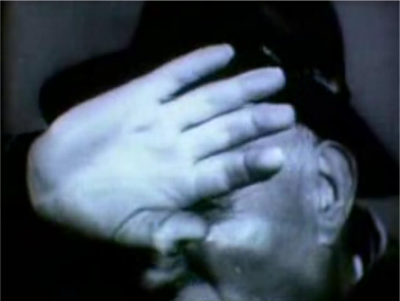
It's really quite impressive for 1951, lots of startlingly affecting archetypal images. You can see all the "Bris Soap" ads here.
RIP Ingmar Bergman (1918 - 2007)
"All great discoveries are made by men whose feelings run ahead of their thinking" - C. H. Parkhurst














Dan Ng recently tipped me off that The New York Times had covered a new campaign by Home Depot in the USA which "taps into the weepy side of reality TV". The article, by Stuart Elliott, describes the campaign as a cross between a reality TV series 'Extreme Makeover: Home Edition' and "commercials for Hallmark Cards"
Elliott says "the intense emotions generated by reality TV, as well as talk shows like Oprah Winfrey’s, are largely because of their focus on so-called real people, prompting marketers like Frito-Lay, Geico, Home Depot and Sears to climb aboard the reality bandwagon".
The lead ad is especially weepy and involves a single mother:
“My name is Amy. Eleven years ago, I was a shy, new single mom, trying to just kind of make it on my own. When I bought the house, and I’ll try not to cry on this one, 15 days after I bought the house, my dad died.”
“He remodeled every house we lived in,” she adds, crying.
Another ad involves an occupational therapist who's been helping her patient (who had suffered a brain anneurism) to remodel her home.
“It takes a lot of courage for someone to get back into their life again,” Tammy says of Phyllis, choking up. “Because of that, Phyllis will always be a hero to me.”
You can see all the stories here.



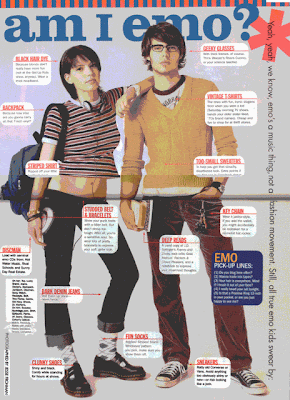

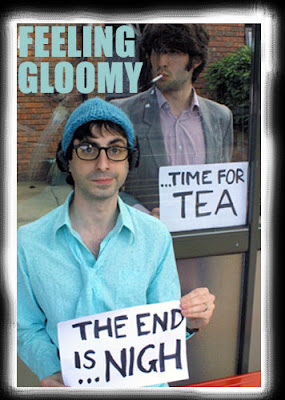




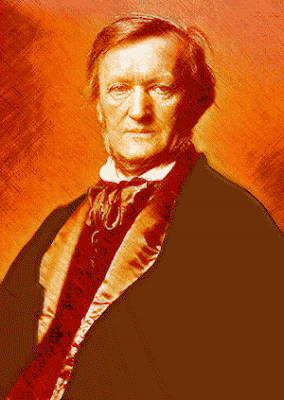

A final point... lack of resolution may leave it open to the consumer to interpret what has happened, what they have felt, what it means... and in an era where consumers define brands as much as marketing professionals... perhaps this is no bad thing?
Well next time I post on this all-negative all-the-time thing I hope to have a little more ammo than a musical analogy... but even if it is the case that an all-negative ad would just leave me feeling "bewildered and upset", the last paragraph of my Admap article suggests that could be quite a nice experience.







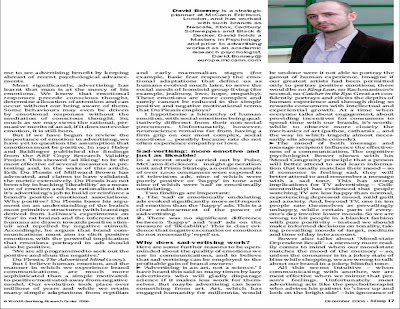


“I learned my trade at HHCL, where we set out to be different…. and in a world where most ads were young, bubbly, irreverent… it was clear something poignant would cut through”.
It just so happens Naresh went on to win a Cannes Gold for Maxell Tapes with “Israelites”. But, interestingly, the script I opened with was HHCL’s first choice when they went to the client… which surely makes it the greatest “sad-vertisement” never to be made.
“Sad-vertising” is my term for those rare and beautiful brand communications that reach a little deeper. Communications with the confidence to make consumers feel something more sophisticated and meaningful than momentarily cheerful or excited. Sad-vertising spurns the convention of using upbeat positivity to stimulate trivial, fluffy emotions in the consumer. Rather it embraces a downbeat tone which flies in the face of superficiality, acknowledging that people, emotions and real life are a confusing mess of ups and downs, all blended into one and nonetheless enjoyable, meaningful and powerful for it.
Now the term “sad-vertising” risks being misleading – for the downbeat communications I allude to do not necessarily leave you feeling sad. On the contrary, because these communications hit deeper, because they may say something more meaningful and truthful, they can leave one feeling affirmed, revived, even exhilarated.
I’d like to see more sad-vertising out there (certainly beyond the charity and public information categories where you’d expect to find it). It says a lot that I had to choose a script which never got made as my archetypal sad-vertisement. Nearly all advertising is upbeat, dealing in happiness, offering shortcuts to gratification through the portrayal of humour, elation, dreams-come-true.
But who wants a world where everything is always upbeat? I think most would say that ‘all upbeat, all the time’ is precisely why most advertising is so perpetually irrelevant and irritating to most consumers. Life contains sadness, empathy, boredom, frustration, anger, jealousy and fear. And advertising all too rarely captures these emotions from which real life is born – the themes of hope, regret, gratification, resilience, ambition, love, hate and competition resonate deeply and are founded upon a confusion of positive and negative emotions. Surely advertising’s reluctance to embrace this full, rich spectrum of emotional life distances us from the consumer, reducing the effectiveness of communications? I’d like to think my job as a creative planner is to ensure our communications touch people – how can I truly do this if prohibited from plumbing the depths of my target’s true emotions?
Many great brands have successfully flirted with sad-vertising, producing memorable and effective ads in the process: “J.R. Hartley” for the Yellow Pages, “Dad” for Mastercard, and others for Orange, Hamlet, Volkswagen, Tennants, Nescafe, Bisto and Smirnoff. Be it an old man who’s life has clearly not made much impact on the world, a girl freshly dumped by her boyfriend, or a child appealing to spend just one night a week eating with her parents and doing “what families do”…these things really get to us, and it’s not purely positive emotions they make us feel.
But, for some reason most brand communications continue to be superficial, inanely upbeat and unrealistic – these are missed opportunities and nothing frustrates me more than having to watch surfing cars, chocolate-induced giggles or blokey slapstick. Despite great brands having had the confidence to produce touching, tonally authentic ads, the consensus is still against sad-vertising.
Seeking the positive, shunning the negative – the argument against sad-vertising
The Cognitive Neuroscientific revolution of the 1990s has led to a renaissance in our understanding of the brain, and as a former research psychologist it pleases me to see advertising benefit by keeping abreast of recent psychological advancements.
Most significantly, advertising has learnt that man is at the mercy of his emotions. We now know that emotional responses precede conscious thought, determine allocation of attention and can even occur without our being aware of them. Some behaviours may even be driven by emotional responses without the mediation of conscious thought. So as much as we may stress about the rational, persuasive merits of an ad - if the ad doesn’t evoke emotion, it is still-born.
But if we have begun to review the importance of emotion in advertising, we have yet to question the assumption that these emotions must be positive. In 1991 Haley and Baldinger published the findings from their “ARF Copy Research Validity Project”. This showed “ad liking” to be the most effective of several measures in pre-testing and, in the wake of this article, Erik Du Plessis of Millward Brown has advocated, and claims to have validated, the metric extensively. Du Plessis has not been shy in backing “likeability” as a measure of emotion and has rationalised that it’s advertising’s job to build or reinforce a brand’s positive emotional associations. Why positive? Du Plessis bases his argument on an understanding of the brain’s most primitive structures (with learnings derived from LeDoux’s experiments on “fear” in rat brains) and the inference that humans are drawn towards positive stimuli and repelled by negative stimuli. Accordingly, he argues that brand communications must aim to elicit positive emotions, with the powerful implication that emotions portrayed in ads should also be positive.
“We are all programmed to seek out the positive and shun the negative”,
Du Plessis, “The Advertised Mind”, (2005).
But I believe human emotion, and the manner in which we experience brand communications, to be so much more sophisticated than a simple motivated-to-positive / motivated-away-from-negative model. Our evolution took place over millions of years and whilst we retain many of the simple adaptations from reptilian and early mammalian stages (e.g. basic fear response) the emotional adaptations that define us as humans evolved much later, to serve the social needs of hominid group-living (e.g. jealousy, love, hope, empathy). These latter emotions are more complex and surely cannot be reduced to the simple positive and negative motivational terms that Du Plessis employs?
I hypothesise a hierarchy of human emotion, with social emotions being qualitatively different from their non-social precursors. Unfortunately, however, Neuroscience remains far from having a firm grip on our most complex, social emotions… possibly because rats do not often experience empathy or love.
Sad-vertising is more emotive and just as likeable!
In a recent study carried out by Pulse, McCann Erickson’s insight generation unit, and Prism Strategy, an online sample of over 1,000 consumers were exposed to 18 television advertisements, 9 of which were purely positive or “happy” in tone and 9 of which were “sad” or emotionally undulating.
Two findings are really important:
1) The “sad” or emotionally undulating ads evoked significantly more self-reported emotion than the “happy” ads. This is a clear endorsement of the power of sad-vertising.
2) There was no significant difference between “happy” and “sad” ads on the measure of “likeability”. This is clear evidence that negative scenarios or emotions do not necessarily “repel” us.
Why does “sad-vertising” work?
Here are some further reasons to be open-minded about the quality of emotions we use in communications, and to believe that sad-vertising can be employed to the profitable gain of brand owners:
- "Advertising is an art, not a science”. I’ve heard this said so many times by lazy advertisers who’ll gladly disparage science if it makes less work for themselves. But maybe advertising can learn something from art. Art, which has engaged humanity for millennia, would be undone were it not able to portray the full gamut of human experience. Imagine if our greatest artists had been permitted only to portray positive emotions; there would be no King Lear, no Rachmaninov’s 2nd, no Catcher In The Rye. Great art confidently portrays and elicits the depths of human experience and through doing so rewards the consumer with intellectual and experiential growth. At a time when everyone talks about engagement, about providing incentive for consumers to spend time with our brands, it’s worthwhile to more closely observe the mechanics of art (pathos, catharsis…. and the way in which tragedy almost necessarily sits alongside comedy).
- The mood of both message and message-recipient have a bearing on the effectiveness of a communication. The cognitive psychologist Bower shows with his “Mood Congruity” principle that a person will better attend to and learn information which tonally matches their mood – so if someone is feeling sad, they will better attend to and remember a message with a sad tone. This has strong implications for television advertising – Csikszentmihalyi has evidenced that people, when watching television, are less happy than normal, experiencing depressed mood, mild guilt and anxiety. And beyond television, 1 in 10 people rate themselves as prevailingly unhappy, whilst certain parts of everyone’s day involve lower mood. So we are wrong to hit people in a blanket fashion with upbeat messaging – instead we should make informed decisions on tonality, taking mood of the target, medium and time of day into account.
Bower also talks about “Mood-state Dependent Recall” - a memory more readily comes to mind when our mood-state matches the mood of the memory – so, unless the consumer is in an upbeat, blissful state whilst shopping, we are wrong to talk about our brand in an upbeat, blissful tone.
All this seems intuitive – when communicating wth another, we are most effective when we mirror that person’s feelings. Unfortunately most advertising acts like the psychotherapist who advises his patient to “cheer up and look on the bright side” – his ignorance of patient feelings and dearth of empathy make for an ineffective intervention.
- Is your brand someone I’d like to hang out with? Or is it the irritatingly and inauthentically happy person one meets at a party who, through saying only positive, predictable things, is quickly identified as being of zero interest? Likeability is so very important in a world where we feed our identity with brand choices and evaluate brands as we would people. If we like people who are “real”, authentic, similar to us, honest and interesting, then surely brands with more complicated moods will stimulate greater likeability?
We bond with others through adversity, shared experience, the exchange of uncomfortable truths about ourselves. And we indicate we are open to sharing a more intimate relationship by displaying our vulnerabilities. So why do brands not behave like this?
Interestingly, Du Plessis in “The Advertised Mind” reports that “empathy” and “meaningfulness” are important facets of “likeability” for an ad.
- Humans can be drawn to negative affect. Not only can depression be functional, designed by evolution to motivate reappraisal and change in behaviour, but our evolved capacity for empathy makes us responsive to sadness in other humans – we want to help, to console, to cheer-up. If your brand behaves like a person who is vulnerable, humble, occasionally in need of support, might the consumer suspend his cynicism, increase his empathy and spend more time listening to what you have to say?
- The experience of positive and negative emotion may not be all that different – in fact all emotion may have the same initial impact on the body (the autonomic responses of increased heart-rate, adrenaline, etc.). Emotion may only be labelled as good or bad as a result of subsequent, higher-brain-processing, when the cortex uses context to decide why an emotion has been aroused.
In fact so similar is the experience of positive and negative emotion that they are readily confused. Consider the principle of “Excitation Transfer” or “Love at First Fright” as researched in the1970s and 80s. One study showed that the emotional arousal you experience on a rollercoaster can easily be misattributed to the person you’re sitting beside – that is, what we would normally describe as a fear response could wrongly be interpreted as the early stages of sexual attraction – exactly the same physiological experience, but subject to different labelling because of context.
So, the means by which we arouse consumers shouldn’t matter - “positive” stimuli (a gurgling baby, a smile) and “negative” stimuli (a crying girl, a death) may have the same initial attention-grabbing impact. After that, it’s up to the brand to provide a context in which it becomes associated with the heightened emotion or supplies a positive resolution to the emotional journey.
- Finally, I believe positive emotions are experienced more intensely when preceded by negative emotions. Sad-vertising probably works best when the brand offers a positive, cathartic finale after arousing a glut of sadder emotions. Consider the iconic “Hamlet” advertising – the meaning of “happiness” is entirely dependent on the misfortune that precedes it. And for J.R. Hartley, finding his book is all the sweeter after repeated failures to do so.
Conclusion
As a consumer, I want to be moved by advertising, to experience something true, meaningful and life-enhancing. As an advertiser, I want to feel proud of my work - and sad-vertising gives me scope to bring texture to consumers’ emotional and mental lives, to adopt moral and meaningful stand-points, just as art does. But most importantly, for those brand-owners wise enough not to put the entirety of their investment behind positive emotion, sad-vertising is extremely emotive, has the capacity to connect with an increasingly sophisticated consumer, and must ultimately be a more effective return-on-investment.
So here’s to a time when advertising reflects the true complexity of human emotion. I leave you with a taste of this complexity and the undoubted wisdom of “South Park”.
“I love life...Yeah, I'm sad, but at the same time, I'm really happy that something could make me feel that sad. It's like...It makes me feel alive, you know. It makes me feel human. The only way I could feel this sad now is if I felt something really good before. So I have to take the bad with the good. So I guess what I'm feeling is like a beautiful sadness.”
Trey Parker & Matt Stone, South Park “Raisins” 2003.

